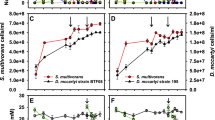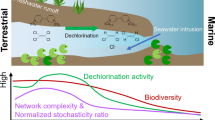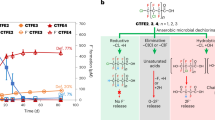Abstract
In the microbial reductive dechlorination of tetrachloroethene (PCE) and trichloroethene (TCE), dechlorinators usually produce cis-1,2-dichloroethene (cis-DCE) as the predominant product or an intermediate. This study shows that dechlorination of PCE and TCE can also lead to the generation of trans-1,2-dichloroethene (trans-DCE) by a co-culture MB. During its enrichment process, the ratio of trans- to cis-DCE increased from 1.4 (±0.1):1–3.7 (±0.4):1, whereas the TCE reductive dechlorination rate went up from ∼26.2 to ∼68.8 μmol l−1 day−1. PCR–denaturing gradient gel electrophoresis (PCR-DGGE) revealed that the increased ratio of trans- /cis-DCE was well correlated with the increased proportions of Dehalococcoides and the disappearance of Desulfuromonas during the enrichment process. As shown by PCR-DGGE, similar Dehalococcoides species were consistently present in another three sediment-free cultures with various trans- /cis-DCE ratios. The 16S rRNA gene sequence of this Dehalococcoides sp. in co-culture MB is 100% identical (over 1489 bp) to that of Dehalococcoides ethenogenes strain 195 (CP000027), which belongs to the Cornell subgroup of the Dehalococcoides cluster. The other bacterium in this co-culture MB was a Sedimentibacter species, which showed no PCE or TCE dechlorination activity. Results from this study show that microbial dechlorination of chloroethenes by this particular subgroup of Dehalococcoides could result in significant accumulation of trans-DCE in the environment if no trans-DCE dechlorinators coexist in the contaminated sites.
Similar content being viewed by others
Log in or create a free account to read this content
Gain free access to this article, as well as selected content from this journal and more on nature.com
or
References
Abelson PH . (1990). Inefficient remediation of ground-water pollution. Science 250: 73.
Arnold WA, Roberts AL . (1998). Pathways of chlorinated ethylene and chlorinated acetylene reaction with Zn(0). Environ Sci Technol 32: 3017–3025.
ATSDR (2007). Agency for Toxic Substances and Disease Registry. US Public Health Service, U S Department of Health and Human Services: Atlanta, GA.
Bunge M, Adrian L, Kraus A, Opel M, Lorenz WG, Andreesen JR et al. (2003). Reductive dehalogenation of chlorinated dioxins by an anaerobic bacterium. Nature 421: 357–360.
Cole JR, Cascarelli AL, Mohn WW, Tiedje JM . (1994). Isolation and characterization of a novel bacterium growing via reductive dehalogenation of 2-chlorophenol. Appl Environ Microbiol 60: 3536–3542.
Duhamel M, Mo K, Edwards EA . (2004). Characterization of a highly enriched Dehalococcoides-containing culture that grows on vinyl chloride and trichloroethene. Appl Environ Microbiol 70: 5538–5545.
Futamata H, Yoshida N, Kurogi T, Kaiya S, Hiraishi A . (2007). Reductive dechlorination of chloroethenes by Dehalococcoides-containing cultures enriched from a polychlorinated-dioxin-contaminated microcosm. ISME J 1: 471–479.
Griffin BM, Tiedje JM, Löffler FE . (2004). Anaerobic microbial reductive dechlorination of tetrachloroethene to predominately trans-1,2-Dichloroethene. Environ Sci Technol 38: 4300–4303.
He J, Holmes VF, Lee PKH, Alvarez-Cohen L . (2007). Influence of vitamin B12 and cocultures on the growth of Dehalococcoides isolates in defined medium. Appl Environ Microbiol 73: 2847–2853.
He J, Ritalahti KM, Aiello MR, Löffler FE . (2003a). Complete detoxification of vinyl chloride by an anaerobic enrichment culture and identification of the reductively dechlorinating population as a Dehalococcoides species. Appl Environ Microbiol 69: 996–1003.
He J, Ritalahti KM, Yang K-L, Koenigsberg SS, Löffler FE . (2003b). Detoxification of vinyl chloride to ethene coupled to growth of an anaerobic bacterium. Nature 424: 62–65.
He J, Sung Y, Dollhopf ME, Fathepure BZ, Tiedje JM, Löffler FE . (2002). Acetate versus hydrogen as direct electron donors to stimulate the microbial reductive dechlorinaton process at chloroethene-contaminated sites. Environ Sci Technol 36: 3945–3952.
He J, Sung Y, Krajmalnik-Brown R, Ritalahti KM, Löffler FE . (2005). Isolation and characterization of Dehalococcoides sp. strain FL2, a trichloroethene (TCE)- and 1,2-dichloroethene-respiring anaerobe. Environ Microbiol 7: 1442–1450.
Hendrickson ER, Payne JA, Young RM, Starr MG, Perry MP, Fahnestock S et al. (2002). Molecular analysis of Dehalococcoides 16S ribosomal DNA from chloroethene-contaminated sites throughout North America and Europe. Appl Environ Microbiol 68: 485–495.
Holliger C, Hahn D, Harmsen H, Ludwig W, Schumacher W, Tindall B et al. (1998). Dehalobacter restrictus gen. nov. and sp. nov., a strictly anaerobic bacterium that reductively dechlorinates tetra- and trichloroethene in an anaerobic respiration. Arch Microbiol 169: 313–321.
Holmes VF, He J, Lee PKH, Alvarez-Cohen L . (2006). Discrimination of multiple Dehalococcoides strains in a trichloroethene enrichment by quantification of their reductive dehalogenase genes. Appl Environ Microbiol 72: 5877–5883.
Hölscher T, Krajmalnik-Brown R, Ritalahti KM, von Wintzingerode F, Görisch H, Löffler FE et al. (2004). Multiple nonidentical reductive-dehalogenase-homologous genes are common in Dehalococcoides. Appl Environ Microbiol 70: 5290–5297.
Kittelmann S, Friedrich MW . (2008). Novel uncultured Chloroflexi dechlorinate perchloroethene to trans-dichloroethene in tidal flat sediments. Environ Microbiol 10: 1557–1570.
Krajmalnik-Brown R, Hölscher T, Thomson IN, Saunders FM, Ritalahti KM, Löffler FE . (2004). Genetic identification of a putative vinyl chloride reductase in Dehalococcoides sp. strain BAV1. Appl Environ Microbiol 70: 6347–6351.
Lane DJ, Pace B, Olsen GJ, Stahl DA, Sogin ML, Pace NR . (1985). Rapid determination of 16S ribosomal RNA sequences for phylogenetic analyses. Proc Natl Acad Sci USA 82: 6955–6959.
Löffler FE, Champine JE, Ritalahti KM, Sprague SJ, Tiedje JM . (1997). Complete reductive dechlorination of 1,2-dichloropropane by anaerobic bacteria. Appl Environ Microbiol 63: 2870–2875.
Löffler FE, Sun Q, Li J, Tiedje JM . (2000). 16S rRNA gene-based detection of tetrachloroethene-dechlorinating Desulfuromonas and Dehalococcoides species. Appl Environ Microbiol 66: 1369–1374.
Magnuson JK, Stern RV, Gossett JM, Zinder SH, Burris DR . (1998). Reductive dechlorination of tetrachloroethene to ethene by a two-component enzyme pathway. Appl Environ Microbiol 64: 1270–1275.
Maymó-Gatell X, Chien Y-T, Gossett JM, Zinder SH . (1997). Isolation of a bacterium that reductively dechlorinates tetrachloroethene to ethene. Science 276: 1568–1571.
Miller GS, Milliken CE, Sowers KR, May HD . (2005). Reductive dechlorination of tetrachloroethene to trans-dichloroethene and cis-dichloroethene by PCB-dechlorinating bacterium DF-1. Environ Sci Technol 39: 2631–2635.
Müller JA, Rosner BM, von Abendroth G, Meshulam-Simon G, McCarty PL, Spormann AM . (2004). Molecular identification of the catabolic vinyl chloride reductase from Dehalococcoides sp. strain VS and its environmental distribution. Appl Environ Microbiol 70: 4880–4888.
Nijenhuis I, Nikolausz M, Köth A, Felföldi T, Weiss H, Drangmeister J et al. (2007). Assessment of the natural attenuation of chlorinated ethenes in an anaerobic contaminated aquifer in the Bitterfeld/Wolfen area using stable isotope techniques, microcosm studies, and molecular biomarkers. Chemosphere 67: 300–311.
Regeard C, Maillard J, Dufraigne C, Deschavanne P, Holliger C . (2005). Indications for acquisition of reductive dehalogenase genes through horizontal gene transfer by Dehalococcoides ethenogenes strain 195. Appl Environ Microbiol 71: 2955–2961.
Seshadri R, Adrian L, Fouts DE, Eisen JA, Phillippy AM, Methe BA et al. (2005). Genome sequence of the PCE-dechlorinating bacterium Dehalococcoides ethenogenes. Science 307: 105–108.
Smidt H, de Vos WM . (2004). Anaerobic microbial dehalogenation. Annu Rev Microbiol 58: 43–73.
Sung Y, Ritalahti KM, Apkarian RP, Löffler FE . (2006). Quantitative PCR confirms purity of strain GT, a novel trichloroethene-to-ethene respiring Dehalococcoides isolate. Appl Environ Microbiol 72: 1980–1987.
SWMU9 (2002). Treatability study annual monitoring report. Naval air facility: Key West, Florida. Contract number N62407-94-D-0888, contract task order 0188. Tetra Tech NUS, Inc for Southern Division Naval Facilities Engineering Command.
van Doesburg W, van Eekert MHA, Middeldorp PJM, Balk M, Schraa G, Stams AJM . (2005). Reductive dechlorination of β-hexachlorocyclohexane (β-HCH) by a Dehalobacter species in coculture with a Sedimentibacter sp. FEMS Microbiol Ecol 54: 87–95.
Waller AS, Krajmalnik-Brown R, Löffler FE, Edwards EA . (2005). Multiple reductive-dehalogenase-homologous genes are simultaneously transcribed during dechlorination by Dehalococcoides-containing cultures. Appl Environ Microbiol 71: 8257–8264.
Wolin EA, Wolin MJ, Wolfe RS . (1963). Formation of methane by bacterial extracts. J Biol Chem 238: 2882–2886.
Zhang J, Joslyn AP, Chiu PC . (2006). 1,1-Dichloroethene as a predominant intermediate of microbial trichloroethene reduction. Environ Sci Technol 40: 1830–1836.
Zhou J, Fries MR, Chee-Sanford JC, Tiedje JM . (1995). Phylogenetic analysis of a new group of denitrifiers capable of anaerobic growth on toluene and description of Azoarcus tolulyticus sp. nov. Int J Syst Bacteriol 45: 500–506.
Acknowledgements
This research was supported by the Academic Research Fund from the Singapore Ministry of Education under Project No.: R-288-000-024-112/133 and R-288-000-041-112. The sequences of primers used in this study and the comparison of the 16S rRNA gene sequences for selected chloroethene-dechlorinating isolates and uncultured clones are listed in the supporting information.
Author information
Authors and Affiliations
Corresponding author
Additional information
Supplementary Information accompanies the paper on The ISME Journal website (http://www.nature.com/ismej)
Supplementary information
Rights and permissions
About this article
Cite this article
Cheng, D., Chow, W. & He, J. A Dehalococcoides-containing co-culture that dechlorinates tetrachloroethene to trans-1,2-dichloroethene. ISME J 4, 88–97 (2010). https://doi.org/10.1038/ismej.2009.90
Received:
Revised:
Accepted:
Published:
Issue date:
DOI: https://doi.org/10.1038/ismej.2009.90
Keywords
This article is cited by
-
Interspecies metabolite transfer and aggregate formation in a co-culture of Dehalococcoides and Sulfurospirillum dehalogenating tetrachloroethene to ethene
The ISME Journal (2021)
-
Growth of Dehalococcoides mccartyi species in an autotrophic consortium producing limited acetate
Biodegradation (2018)
-
Isolation, identification and characterization of a novel Ralstonia sp. FD-1, capable of degrading 4-fluoroaniline
Biodegradation (2014)
-
Site-specific pre-evaluation of bioremediation technologies for chloroethene degradation
International Journal of Environmental Science and Technology (2014)
-
Dechlorination and organohalide-respiring bacteria dynamics in sediment samples of the Yangtze Three Gorges Reservoir
Environmental Science and Pollution Research (2013)



